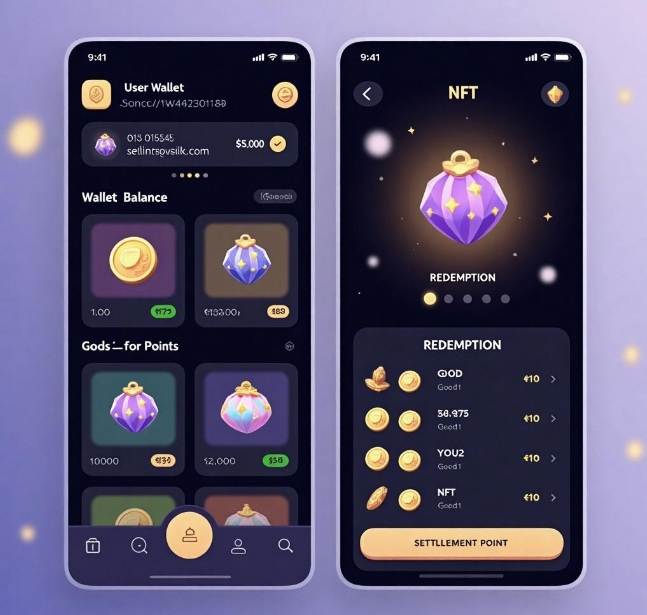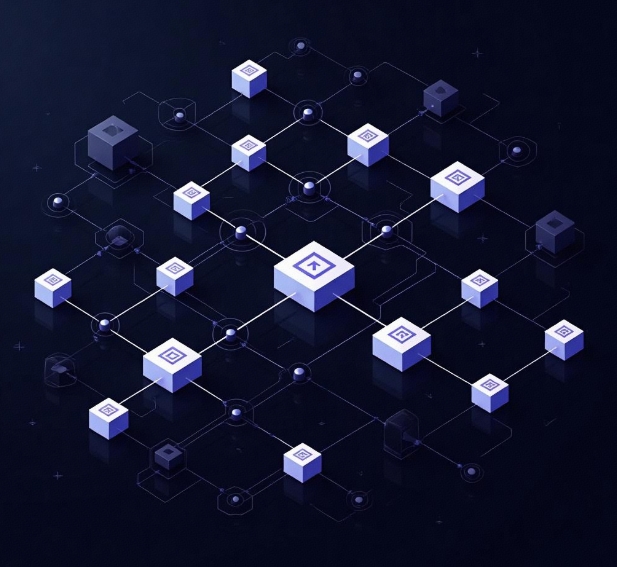Web3 Points Mall Development Kit
- latest articles
- 1.DApp Development & Customization: Merging Diverse Market Needs with User Experience 2.Analysis of the Core Technical System in DApp Project Development 3.How to achieve cross-chain interoperability in Web3 projects? 4.How does the tokenization of points reconstruct the e-commerce ecosystem? 5.How to Set and Track Data Metrics for a Points Mall? 6.What is DApp Development? Core Concepts and Technical Analysis 7.Inventory of commonly used Web3 development tools and usage tips 8.Development of a Distribution System Integrated with Social E-commerce 9.Six Key Steps for Businesses to Build a Points Mall System 10.What is DApp Development? A Comprehensive Guide from Concept to Implementation
- Popular Articles
- 1.Future Trends and Technology Predictions for APP Development in 2025 2.Analysis of the DeFi Ecosystem: How Developers Can Participate in Decentralized Finance Innovation 3.From Zero to One: How PI Mall Revolutionizes the Traditional E-commerce Model 4.DAPP Development | Best Practices for Professional Customization and Rapid Launch 5.Recommended by the Web3 developer community: the most noteworthy forums and resources 6.From Cloud Computing to Computing Power Leasing: Building a Flexible and Scalable Computing Resource Platform 7.How to Develop a Successful Douyin Mini Program: Technical Architecture and Best Practices 8.Shared Bike System APP: The Convenient Choice in the Era of Smart Travel 9.How to Create a Successful Dating App: From Needs Analysis to User Experience Design 10.From Design to Development: The Complete Process of Bringing an APP Idea to Life
With the rapid development of blockchain technology, the Web3 ecosystem is reshaping the business models and user interaction methods of the internet. Among them, points marketplaces, as a crucial component of user loyalty programs, are also undergoing a transformation from traditional Web2 models to Web3 models. This article will delve into the development toolkit for Web3 points marketplaces, including core components, technology selection, development processes, and application scenarios, to help developers build decentralized points marketplaces more efficiently.
I. Overview of Web3 Points Marketplaces
1.1 What is a Web3 Points Marketplace?
A Web3 points marketplace is a decentralized points management and redemption system built on blockchain and smart contract technology, designed to enhance the liquidity, security, and operability of points. Compared to traditional Web2 points systems, Web3 points marketplaces have the following characteristics:
Decentralization: Utilizes blockchain technology to make points data transparent and immutable.
Assetization: Points can exist in tokenized form, enabling broader liquidity.
Smart Contract Execution: Transaction rules are automatically executed by smart contracts, eliminating the need for third-party intervention.
Cross-Platform Compatibility: Supports interoperability between multiple DApps (decentralized applications) and blockchain networks.
1.2 Core Advantages of Web3 Points Marketplaces
Tamper-Proof and High Security: The blockchain ledger is immutable, ensuring the security and transparency of points.
Enhanced User Loyalty: Points hold real value and can be redeemed for NFTs, physical goods, or other Web3 services.
Reduced Operational Costs: Eliminates intermediaries in traditional points systems, reducing management and maintenance costs.
Support for Multi-Chain Interoperability: Web3 points systems can operate across multiple blockchains, improving user experience and market coverage.
II. Web3 Points Marketplace Development Toolkit
To help developers quickly build Web3 points marketplaces, we have compiled a comprehensive development toolkit covering blockchain infrastructure, smart contracts, front-end development frameworks, and API integration solutions.
2.1 Blockchain Infrastructure
Selecting the appropriate blockchain platform is the primary task for building a Web3 points marketplace. Currently, the following blockchain platforms are well-suited for points marketplace development:
Ethereum: Powerful smart contract functionality with a mature ecosystem, but higher transaction fees.
Polygon (MATIC): A Layer 2 solution for Ethereum with lower transaction costs, suitable for large-scale applications.
BNB Chain: Fast transaction speeds and low fees, ideal for building high-frequency trading points marketplaces.
Solana: Known for high performance, suitable for points systems requiring high throughput.
Developers can choose the appropriate blockchain platform based on business needs and utilize corresponding SDKs and APIs for development.
2.2 Smart Contract Development Tools
The core logic of a Web3 points marketplace is primarily implemented through smart contracts. The following are commonly used smart contract development tools:
Solidity: The primary programming language for smart contracts on Ethereum and EVM-compatible chains.
Hardhat: A development environment for local development, testing, and deployment of Solidity smart contracts.
Truffle: Provides a comprehensive framework for developing, testing, and deploying smart contracts.
OpenZeppelin: Offers secure smart contract templates that can be used for token management in points marketplaces.
Example: A points token (ERC-20) smart contract written in Solidity:
solidity
// SPDX-License-Identifier: MIT
pragma solidity ^0.8.0;
import "@openzeppelin/contracts/token/ERC20/ERC20.sol";
contract RewardToken is ERC20 {
constructor() ERC20("RewardToken", "RWT") {
_mint(msg.sender, 1000000 * 10 ** decimals());
}
}
2.3 Front-End Development Frameworks
The front-end of Web3 applications is typically developed using the following frameworks:
React.js: Combined with Web3.js or Ethers.js to build DApp front-ends.
Next.js: Supports server-side rendering, improving the performance and SEO friendliness of Web3 applications.
Vue.js: A lightweight framework suitable for highly interactive DApp interfaces.
Additionally, the front-end needs to integrate Web3 interaction libraries, such as:
Web3.js: Used for interacting with the Ethereum blockchain.
Ethers.js: A more lightweight Web3 interaction library, commonly used in DApp development.
WalletConnect: Supports connecting to various Web3 wallets (such as MetaMask).
Example: Using Ethers.js to connect a wallet and retrieve the user's address:
import { ethers } from "ethers";
async function connectWallet() {
if (window.ethereum) {
const provider = new ethers.providers.Web3Provider(window.ethereum);
await provider.send("eth_requestAccounts", []);
const signer = provider.getSigner();
console.log("Wallet address:", await signer.getAddress());
} else {
console.log("Please install MetaMask!");
}
}
2.4 API and Data Storage Solutions
In Web3 points marketplaces, API and data storage solutions primarily include:
The Graph: Provides decentralized data indexing services to improve query efficiency.
IPFS (InterPlanetary File System): Used for storing product information, NFT redemption data, etc., in points marketplaces.
Moralis: Provides Web3 data APIs to simplify access to blockchain data.
Alchemy/Infura: Provides API access services for Ethereum and other blockchains.
III. Development Process of Web3 Points Marketplaces
Requirements Analysis and Design
Define the points system: Methods for earning points, redemption rules, and circulation models.
Select a blockchain platform: Choose an appropriate chain based on requirements, such as Ethereum, Polygon, or BNB Chain.
Design smart contracts: Define token standards for points (e.g., ERC-20, ERC-721).
Smart Contract Development and Testing
Use Solidity to write smart contracts for points management and redemption.
Use Hardhat for local testing and debugging.
Deploy smart contracts on testnets (e.g., Ropsten, Goerli).
Front-End DApp Development
Use React.js or Vue.js to develop the user interface.
Integrate Ethers.js to connect wallets and implement user authentication.
Retrieve on-chain points data via Web3 APIs and display it.
Deployment and Launch
Use Hardhat or Truffle to deploy smart contracts to the mainnet.
Configure IPFS for storing marketplace data to ensure decentralized storage.
Use The Graph for fast data queries.
IV. Application Scenarios of Web3 Points Marketplaces
E-commerce Platforms: Users accumulate points through shopping and redeem them for NFTs or goods in Web3 points marketplaces.
Gaming Industry: Players earn points by completing tasks and can redeem them for in-game items or other digital assets.
Social Media: Users earn points through likes, shares, and comments, which can be used to unlock paid content or tip creators.
Offline Consumption Rewards: Brands and merchants launch decentralized points systems based on Web3 technology to enhance user engagement.
Conclusion
The development toolkit for Web3 points marketplaces encompasses blockchain infrastructure, smart contract development, front-end frameworks, and data storage solutions, providing developers with comprehensive technical support. In the future, as the Web3 ecosystem matures, points marketplaces will be widely adopted across various industries, driving innovation and development in user incentive mechanisms.
-

How does the tokenization of points reconstruct the e-commerce ecosystem?
With the continuous advancement of internet technology and the gradual prolifera···
-

How to Set and Track Data Metrics for a Points Mall?
With the rapid development of the e-commerce industry, points malls, as a common···
-

Development of a Distribution System Integrated with Social E-commerce
With the rapid development of internet technology, the e-commerce industry has e···

 Blockchain
Blockchain












